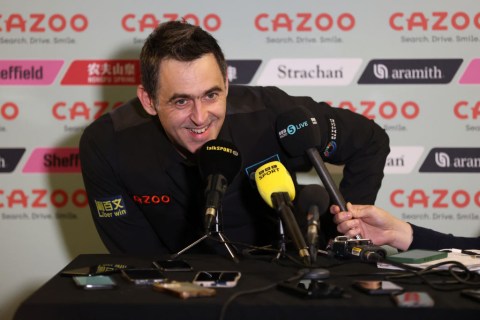
🏆 Legendary Appeal :“Ronnie O’Sullivan and Joe Johnson Lead the Charge for Snooker’s Game-Changing Quickfire Revolution..
A new, streamlined format in snooker has garnered the backing of one of the sport’s biggest names — Ronnie O’Sullivan — in part to tackle a longstanding frustration of his:
the slow, defence-heavy frames that dominate some traditional tournaments. Along with fellow legends such as Joe Johnson, O’Sullivan has lent his weight to the concept of a rapid-fire format designed to accelerate matches, increase unpredictability and deliver a more spectator-friendly experience.
—
The format: “900” (15-minute frames)
Dubbed the Snooker 900, the new format introduces a number of tweaks to conventional snooker rules to ensure action, speed and entertainment. According to the report, frames are limited to 900 seconds (i.e., 15 minutes) and a 20-second shot clock is imposed. One major rule change: every shot must either pot a ball or hit a cushion after contact, thereby eliminating bare rolls or overly cautious safety plays. Fouls result in “cue ball in hand” for the opponent.
O’Sullivan says that the format “forces you to play like that” — meaning, more attacking, more instinctive, less calculated defence. He pointed out that for many potential viewers, sitting through a long, slow frame is off-putting; this format gives a complete match (or a whole frame) in a short package.
—
Why it addresses O’Sullivan’s pet hate
Over the course of his career, O’Sullivan has repeatedly voiced frustration with aspects of modern snooker that he believes slow the game and dilute its entertainment value. For example, he once criticised referees for calling fouls too readily and allowing matches to stagnate. His broader concern has been that the finely tuned tactical battles, while impressive, can make matches drag, losing viewers and reducing the spectacle.
The Snooker 900 format speaks directly to that issue: fewer protracted safety duels, more potting, less dead time. O’Sullivan believes younger players will take to it, and new audiences who might not commit to multi-hour contests could engage with this faster version. As he put it: “I think most people playing the game, they’ll want to play like … myself … but this format actually forces you to play like that.”
—
Support from the legends and wider context
While O’Sullivan is the headline supporter, the idea has attracted interest from other senior figures. The concept of “legends leagues” built around this format (including names like Joe Johnson) has been mooted for exhibitions and invitational tournaments. The idea: mix top professionals, icons, rising stars all in a format that emphasises flair and pace.
Moreover, this is part of a broader trend in snooker: recognising that the game’s traditional format — long frames, deep tactical play, sessions lasting hours — may struggle to engage casual or younger viewers in an age of short-form entertainment. It dovetails with digital streaming, social media snippets, and globalising the sport.
—
Practicalities and the potential ripple effects
Under Snooker 900:
Frames last a maximum of 15 minutes (900 seconds).
A 20-second (or in some versions 15/10) shot clock presses players.
To discourage stalling, every shot must either pot a ball or hit a cushion.
Fouls give the opponent cue ball in hand.
Sudden-death blue-ball shootouts may decide tied matches.
For players, this demands a shift: less time for elaborate safety build-ups, quicker decision-making, bolder potting. For organisers and broadcasters, the format offers shorter sessions, a more predictable broadcast window, and potentially more “highlight”-friendly content.
If widely adopted, the format could influence how younger players develop — perhaps favouring those comfortable under time pressure and less endless safety strategy. It might also open up new event types: fast-fire tournaments, perhaps regional or online-streamed events appealing to a broader audience.
—
What this means for the sport
The backing of Ronnie O’Sullivan gives the format credibility — it’s not coming from peripheral promoters, but from one of the sport’s all-time greats who has long been vocal about game evolution. His view: change is necessary if snooker is to thrive and grow.
There are also potential benefits in terms of outreach. As noted in its launch coverage, Snooker 900 may create more visible opportunities for juniors, women players, disabled players and amateurs by lowering the barrier — shorter frames, more chance for upsets, more accessible broadcasts.
Yet there are challenges. Purists will argue that part of snooker’s beauty lies in the long tactical frames, the mental endurance, the subtle safety exchanges. A move to “faster” might trade depth for instant appeal. Also, ensuring that the format doesn’t become a novelty or overshadow the traditional game will be key — there must still be space for both styles.
—
Conclusion
In endorsing the Snooker 900 format, Ronnie O’Sullivan is signalling a conscious pivot in the sport: one that confronts the very issue he has long decried — slow, overly cautious frames that risk alienating new fans. With its 15-minute frames, shot-clock pressure and requirement for proactive play, the format is designed to inject pace, unpredictability and entertainment punch.
Whether Snooker 900 becomes a full-blown alternative to the traditional format or remains a complementary exhibition circuit remains to be seen. But thanks to O’Sullivan’s support, and the participation of legends like Joe Johnson, this evolution is no longer a fringe curiosity — it may well be the next frontier for snooker’s global growth. If nothing else, it offers a fresh reading of what cue sport can be: faster, flashier, and perhaps more in tune with the audience of today.
Leave a Reply